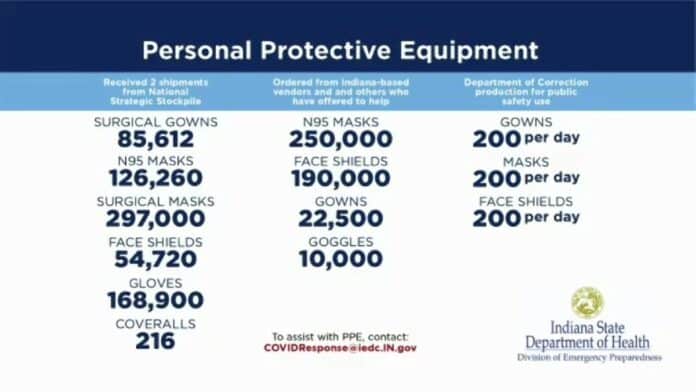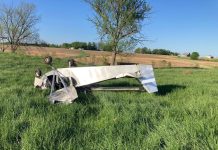
INDIANAPOLIS — State officials on Monday outlined their plans to handle a likely surge of COVID-19 patients in the coming weeks, including strategies for doubling critical care capacity at hospitals throughout Indiana and increasing supplies and medical personnel by using retired health care workers and medical students.
In an online press conference on Monday, Gov. Eric Holcomb, State Health Commissioner Dr. Kris Box and Dr. Jennifer Sullivan, secretary of the Indiana Family and Social Services Administration, said they expect to start seeing COVID-19 patients flooding Indiana hospitals sometime in the next two to eight weeks as the virus continues to spread across the state.
There were 1,786 confirmed cases of COVID-19 in Indiana, and 35 deaths, as of Monday, according to the Indiana State Department of Health. There have been 13 cases reported in Bartholomew County, but no deaths, according to local reports.
“We believe that Indiana’s COVID-19 patient surge will begin soon, and peak surge is expected to be mid-April to mid-May,” Sullivan said. “Every hospital and hospital system in Indiana has been working on a surge plan and we have been discussing those plans as a cross-sector group.”
[sc:text-divider text-divider-title=”Story continues below gallery” ]
Currently, Indiana has 1,940 critical care beds, or ICU beds, and had 1,177 ventilators as of March 1, Sullivan said.
Columbus Regional Hospital has “more than 50” ventilators and is licensed for 225 beds, hospital officials said last week. About 60% of critical care beds are currently in use across the state, Box said.
Indiana is projected to reach its peak number of COVID-19 patients on April 17 and would need an estimated additional 402 ventilators to treat the expected surge in patients, according to the Institute for Health Metrics and Evaluation, an independent population health research center at University of Washington Medicine.
State officials said they hope to double the number of ventilators in the state, including by attempting to “repurpose” anesthesia machines into ventilators, state officials said.
So far Indiana has received 85,612 surgical gowns, 126,260 N95 masks, 297,000 surgical masks, 54,720 face shields, 168,900 gloves and 216 coveralls from the National Strategic Stockpile, state health department officials said.
The state of Indiana has ordered 250,000 N95 masks, 190,000 face shields, 22,500 gowns and 10,000 goggles from Indiana-based vendors and others who have offered to help.
Currently, the Indiana Department of Corrections is producing 200 gowns, mask and face shields per day.
Sullivan said Indiana hospitals could double their bed capacity by canceling elective surgeries, turning other spaces and facilities, including operating and recovery suites, into critical care beds and ending outpatient surgeries not connected to the hospital and using those facilities for beds.
Additionally, hospital systems are coordinating with each other to share equipment in case one of them starts to run low and have devised plans to send less critical patients to alternate facilities, including neighborhood hospitals, medical clinics and unused floors of a state-run hospital in Indianapolis, state officials said.
Recently closed hospitals in Michigan City and St. Joseph County have been directed to open, Sullivan said.
Columbus Regional Hospital had previously canceled or postponed elective surgeries, and, in a worst-case scenario, is able to reconfigure the layout of the hospital to incorporate more ICU beds, if necessary, CRH officials said.
“Our goal is to double critical care capacity and the number of ventilators to respond to surge,” Sullivan said. “Indiana has hospitals that can already turn every bed they have into critical care beds and we have identified those sites as possible surge sites in each region.”
All hands on deck
One major constraint and challenge for hospitals to handle the expected surge is personnel, state officials said.
Currently, state health officials are attempting to reallocate doctors and nurses who may not usually work in critical care and train them to treat the expected increase in COVID-19 patients within the next few weeks. Additionally, certain medical students who have finished their coursework and just need to complete their residency and soon-to-graduate nurses are being sought to help with the state’s response to the outbreak, Box said.
“We will also need more clinicians. We will need them to provide care during the surge and also to provide relief to our frontline workers,” said Dr. Lindsay Weaver, chief medical officer at ISDH. “That’s why, right now, we’re asking retired physicians, those clinicians who have not been working because elective surgeries have been postponed, anesthesiologists and medical trainees to step forward.”
This past weekend, state officials, through the state’s professional licensing agency and medical associations, released a survey to find additional healthcare workers who could help in some capacity, Weaver said.
So far, more than 5,300 healthcare professionals in Indiana have volunteered.
“While our immediate efforts have focused on building bed capacity and ventilators, additional surge planning has focused on designating alternate care facilities should our current efforts be exhausted,” Weaver said. “The Indiana National Guard and Indiana Department of Homeland Security, in conjunction with FEMA, are developing facilities that could be stood up in a 72- to 96-hour time frame.”
Indianapolis — an ‘emerging hotspot’
As the spread of COVID-19 continues to increase throughout the United States, federal health officials have warned that new “emerging hotspots” for the disease are cropping up across the country, including Indianapolis.
Around 45% of Indiana’s confirmed cases have occurred in Marion County. U.S. Surgeon General Jerome Adams has identified Indianapolis as one of the “emerging hotspots” in the outbreak, as well as other hard-hit cities, including New Orleans, Detroit and Chicago.
So far, New York City has been the worst hit U.S. city, with at least 36,221 cases and 790 deaths, according to Johns Hopkins University. Emergency field hospitals are being created in Central Park to treat COVID-19 patients and a U.S. Navy medical ship with 1,000 beds has arrived in port in New York, the The Associated Press reported.
Chicago, the nation’s third largest city, has reported at least 3,445 cases and 40 deaths. Last week, Illinois Gov. J.B. Pritzker said the state would have to double the number of available hospital beds in the next two weeks to treat COVID-19 patients if the coronavirus is not contained.
Marion County, which is largely comprised of the city of Indianapolis and located roughly 30 miles north of Bartholomew County, had 804 confirmed cases of the virus, and 12 deaths, as of Monday, according to the Indiana State Department of Health. Marion County’s southern boundary runs just north of Greenwood.
Bartholomew County’s proximity to Indianapolis, however, has raised concerns locally, as three new cases of COVID-19 were reported in Bartholomew County on Monday, raising the countywide total to 13.
“I am definitely concerned that we are in close proximity to a predicted hotspot,” said Dr. Brian Niedbalski, Bartholomew County health officer. “Indianapolis is a bit different due to their higher population and population density which makes it easier to transmit the virus. That’s why social distancing and proper hygiene habits are so important.”
[sc:pullout-title pullout-title=”To view Gov. Eric Holcomb’s executive order” ][sc:pullout-text-begin]
Gov. Eric Holcomb’s executive order on the COVID-19 surge can be read at:
in.gov/gov/files/Executive Order 20-13 Medical Surge.pdf
[sc:pullout-text-end][sc:pullout-title pullout-title=”For more on the Indiana State Department of Health” ][sc:pullout-text-begin]
To learn more about Indiana’s efforts to fight the COVID-19 pandemic, visit:
[sc:pullout-text-end][sc:pullout-title pullout-title=”Donations” ][sc:pullout-text-begin]
The state of Indiana is accepting donations of medical equipment and personal protection equipment and those who have these items to donate are asked to email [email protected].
[sc:pullout-text-end]




